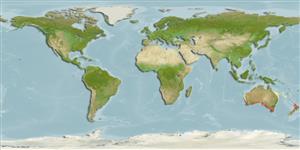>
Eupercaria/misc (Various families in series Eupercaria) >
Labridae (Wrasses)
Etymology: Notolabrus: Greek, noton = back + Greek, labros = voracious (Ref. 45335); tetricus: Specific epithet meaning grim, referring to the rather forbidding appearance of large terminal phase individuals..
More on author: Richardson.
Environment: milieu / climate zone / depth range / distribution range
ນິເວດວິທະຍາ
ສັດທະເລ ກ່ຽວກັນຫີນ; ລະດັບຄວາມເລິກ ? - 50 m (Ref. 9563). Temperate
Southwest Pacific: restricted to southeastern Australia, from New South Wales to South Australia, including Tasmania.
ຂະໜາດ / ນ້ຳໜັກ / Age
Maturity: Lm ? range ? - ? cm
Max length : 50.0 cm TL ຕົວຜູ້/ບໍ່ມີເພດ; (Ref. 9563)
Found on rocky reefs (Ref. 9563).
Life cycle and mating behavior
Maturities | ການສືບພັນ | Spawnings | Egg(s) | Fecundities | ຕົວອ່ອນ
Oviparous, distinct pairing during breeding (Ref. 205).
Russell, B.C., 1988. Revision of the labrid fish genus Pseudolabrus and allied genera. Rec. Aust. Mus. (Suppl. 9):1-72. (Ref. 26203)
IUCN Red List Status (Ref. 130435)
Threat to humans
Harmless
Human uses
ເຄື່ອງມື
Special reports
Download XML
ແຫຼ່ງອີນເຕີເນັດ
Estimates based on models
Preferred temperature (Ref.
123201): 14.3 - 20.6, mean 17.5 °C (based on 130 cells).
Phylogenetic diversity index (Ref.
82804): PD
50 = 0.5078 [Uniqueness, from 0.5 = low to 2.0 = high].
Bayesian length-weight: a=0.01995 (0.00922 - 0.04317), b=2.99 (2.79 - 3.19), in cm total length, based on LWR estimates for this (Sub)family-body shape (Ref.
93245).
ຊັ້ນເຂດຮ້ອນ (Ref.
69278): 3.6 ±0.5 se; based on size and trophs of closest relatives
ຄວາມຢືດຢຸ່ນ (Ref.
120179): ຕຳ່, ປະຊາກອນຕຳ່ສຸດທີ່ໃຊ້ເວລາສອງເທົ່າ 4.5 - 14 ປີ (Preliminary K or Fecundity.).
Fishing Vulnerability (Ref.
59153): Moderate vulnerability (40 of 100).
Nutrients (Ref.
124155): Calcium = 12.1 [5.2, 22.1] mg/100g; Iron = 0.176 [0.091, 0.394] mg/100g; Protein = 18.4 [15.7, 20.8] %; Omega3 = 0.263 [0.137, 0.519] g/100g; Selenium = 7.81 [3.56, 17.29] μg/100g; VitaminA = 39.3 [8.8, 240.8] μg/100g; Zinc = 0.519 [0.327, 0.974] mg/100g (wet weight);
